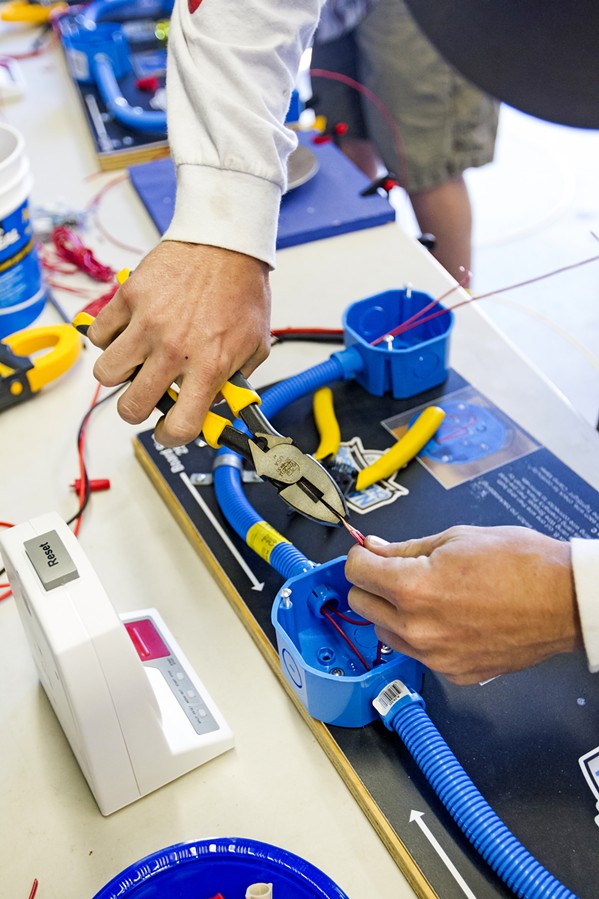It might be 2018, but when it comes to career and technical education programs, John Cascamo says many people's perceptions are still rooted decades in the past.
"Many people think of it in terms of it just being a welding or auto shop class, and those are great," Cascamo, dean of Workforce and Economic Development at Cuesta College, told New Times. "But expansion of career and technical education has been vast."

- Photo By Jayson Mellom
- LEARN A TRADE Career and technical education programs at colleges like Cuesta allow students to get hands-on training and skills to help them get jobs in a number of industries, including electrical technology (above), agriculture, law enforcement, and many others.
Career and technical education programs offer enrollees hands-on training in an array of different careers, and can help them obtain the skills necessary to get a job in their chosen industry. Many of the programs not only allow students to obtain some form of degree, but some also help them obtain professional certifications and licensure in their chosen careers as well.
"Today, CTE is very broad, and there's a wide array of areas and careers it covers," Cascamo said.
The breadth of what is available to college students interested in CTE programs is on display at Cuesta, which currently offers 36 CTE programs. Those programs range from automotive technology, construction, and culinary arts to computer networking technology, criminal justice, and nuclear energy systems, just to name a few. Once enrolled in the programs, students get hands-on training from instructors and professionals who work in those fields, all with the ultimate goal of getting them ready for the workforce.
"These are very good and very well-paying professions," Cascamo said. "All of our programs have very good outcomes when it comes to making people employable."
Cascamo said the programs attract all types of different students, from those who aren't sure what they want to for a living and are experimenting, those who have chosen a career and are looking to get a foot in the door, and even working professionals in their fields who want to sharpen their skills.
In addition, Cuesta also works with SLO County's high schools to offer dual enrollment courses. These courses, which include some CTE programs, feature teachers using the college's curriculum and allow students to earn both high school and college credits.
According to the California Department of Education, nearly 420,000 students in California community colleges participated in a CTE program during the 2016-17 school year. The most popular industry sectors included arts, media and entertainment, information and communications technologies, and agriculture and natural resources.
But CTE programs in California have faced some challenges over the past four years. In 2014, CTE advocate organizations like Get REAL, a nonprofit organization, were alarmed after a report from the California Department of Education noted that in a single year, high school CTE program enrollment dropped by 50,000 students. The group blamed the drop, in part, to a decrease in funding brought on by the impact of the 2008 economic recession.
"The recession hit, and the state scrambled to assist school districts [to] stay finically afloat," Get REAL's website states. "One of the outcomes was categorical flexibility, wherein schools could divert their CTE categorical funding toward non-vocation expenses."
California has since tried to course correct. The state's 2018 budget allocated $150 million in one-time grants for community colleges to develop and implement guided career pathways programs, and increased the Cal Grant program, which provides $1.7 million in financial aid to CTE students. The 2018 budget also allocated $15.3 million for its CTE Initiative Fund, which supports partnership program, technical student organizations, and CTE professional development.
That investment can pay dividends. According to the Association for Career and Technical Education, 92 percent of CTE high school students in the state graduated in the 2016-17 school year, while 88 percent of postsecondary CTE students earned a credential, certificate, or degree.
Cascamo said there were a number of changes that could help strengthen and expand enrollment in CTE programs. That included helping high school counselors become more familiar with trade careers and what they pay, as well as working to change the perception that students can only choose college or CTE, instead of exploring both options.
"I wish every kid got some exposure to a number of shop classes," he said. "I think it would help take away some of that stigma." Δ
Staff Writer Chris McGuinness can be reached at [email protected].
Comments